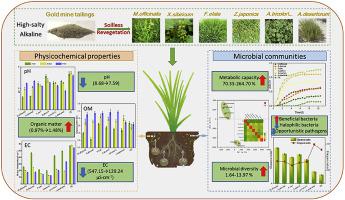Ecotoxicology and Environmental Safety ( IF 6.8 ) Pub Date : 2020-09-11 , DOI: 10.1016/j.ecoenv.2020.111246 Hai Lin 1 , Xinyi Jiang 1 , Bing Li 1 , Yingbo Dong 1 , Ling Qian 2

|
Soilless revegetation is a cost-effective and eco-friendly method for the ecological restoration of gold mine tailings. However, due to gold mine tailings are high-salty, alkaline and low-nutrient, little research has been done on soilless revegetation of gold mine tailings. The aim of study was to apply soilless revegetation to gold mine tailings, and investigate the changes of physicochemical properties and microbial communities of tailings after soilless revegetation. Six selected herbaceous plants (Melilotus officinalis, Xanthium sibiricum, Festuca elata, Zoysia japonica, Amaranthus tricolor L., Artemisia desertorum) grew well on the bare tailings, and their heights reached as high as 16.28 cm after 90 days. After soilless revegetation, tailings salinity dramatically dropped from 547.15 to 129.24 μS cm−1, and pH went down from 8.68 to 7.59 at most. The content of available phosphorus (AP), available nitrogen (AN) and organic matter (OM) in tailings gradually improved, especially the content of AP and OM increased 53.36% and 52.58%, respectively. Furthermore, microbial metabolic activity and diversity in tailings obviously increased 70.33–264.70% and 1.64–13.97% respectively. The relative abundance of potential plant growth-promoting bacteria increased 1.40–3.05%, while the relative abundance of opportunistic pathogens and halophilic bacteria decreased 10.58–17.03% and 2.98–6.52% respectively. Such variations of microbial communities were beneficial for tailings restoration. This study provided insight into soilless revegetation and its impact on tailings microorganisms, which could be a new strategy for ecological restoration of gold mine tailings.
中文翻译:

无土植被:改善高盐金矿尾矿理化特性和重塑微生物群落的有效手段。
无土植被恢复是金矿尾矿生态修复的一种经济高效且生态友好的方法。然而,由于金矿尾矿是高盐,碱性和低养分的,因此关于金矿尾矿的无土植被的研究很少。研究的目的是将无土植被应用于金矿尾矿,并研究无土植被后尾矿的理化性质和微生物群落的变化。六个选定草本植物(黄香草木樨,苍耳,高羊茅,结缕草,苋菜大号。,蒿沙生)在裸露的尾矿上生长良好,它们的高度在90天后达到了16.28厘米。在无土的植被恢复之后,尾矿盐度从547.15μScm -1急剧下降到129.24μScm -1,pH值最多从8.68降至7.59。尾矿中有效磷(AP),有效氮(AN)和有机质(OM)的含量逐渐提高,尤其是AP和OM的含量分别增加了53.36%和52.58%。此外,尾矿中微生物的代谢活性和多样性明显增加了70.33–264.70%和1.64–13.97%。潜在的促进植物生长的细菌的相对丰度提高了1.40–3.05%,而机会病原体和嗜盐细菌的相对丰度分别降低了10.58–17.03%和2.98–6.52%。微生物群落的这种变化有利于尾矿的恢复。这项研究为无土植被及其对尾矿微生物的影响提供了见解,


























 京公网安备 11010802027423号
京公网安备 11010802027423号